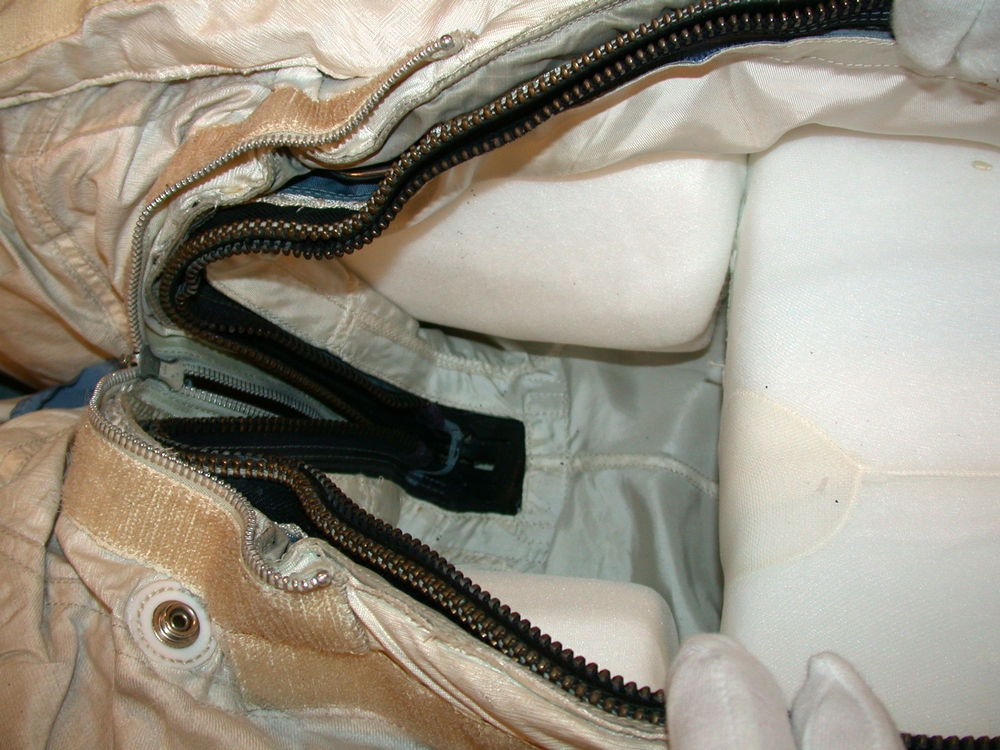1. Code Names
Neil Armstrong's Apollo 11 spacesuit was given the code name Sirius, after the brightest star system in Earth's night sky. Code names were assigned to each member of the Apollo astronaut candidate pool. This allowed NASA to begin ordering the construction of the Apollo spacesuits before they made the official announcement of who had been chosen to crew each mission.
2. Creating a Seal
How do you create an air-tight seal on a zipper? The zipper enclosures on Armstrong's spacesuit actually consist of three layers. Two brass zippers sandwich a rubber layer: zipper, rubber, zipper. When pressurized from the inside of the spacesuit, the rubber expands and create a seal between the two zippers.
3. A Copper Problem
The zippers and synthetic rubber used on the Apollo spacesuits were only meant to have a shelf life of six months. As it was well-known at the time, the rubber used in creating the pressure layer of the suits reacted quite negatively to copper. The zippers on the suits were made of brass. Brass is a mixture of zinc and, you guessed it, copper.
Avoiding copper was especially important in creating the rubber. By accident, an engineer once dropped his copper-tipped pencil into a vat of rubber during processing. This small incident ruined the entire vat. From that day on, pencils were banned from the facility.
The rubber and zippers of the Armstrong suit are especially challenging to conserve because of this reason. The reaction between the copper and rubber cause both substances to degrade.
4. When Nature Calls
Both Armstrong's Apollo 11 spacesuit and Alan Shepard's Mercury spacesuit had ports built in to expel any … ahem … biological waste. Because Shepard's flight was only meant to last 15 minutes his port was never utilized.
What wasn't anticipated were launch delays and hours spent waiting on the launchpad. When nature called, Shepard was faced with two options: scrub the launch or urinate in his spacesuit. Take a guess at which option he chose.
5. Silver Spacesuits
We know that the exterior of Armstrong's spacesuit was largely made of white beta cloth. In comparison, Shepard's spacesuit looks like a futuristic dream in silver. The Mercury spacesuit, however, is made of aluminum coating adhered with adhesive to a green fabric. Over the years, the adhesive has begun to degrade and turn a dark red color. This can be seen in spots where the aluminum coating is flaking off—many mistake this for rust.
6. No Pin Left Behind
All spacesuits are x-rayed at least twice before adorning an astronaut. This is to make sure the seamstresses in charge of sewing the suits have not left any pins behind. The suits are x-rayed once at ILC Dover, a spacesuit manufacturer, and once by NASA.

Did you know Alan Shepard also flew on Apollo 14? Here's an x-ray of his spacesuit. X-ray: Roland H. Cunningham and Mark Avino
7. Glue-Pot Ladies
Much attention is paid to the seamstresses of spacesuits, but the real unsung heroes in spacesuit construction were the "glue-pot ladies." One of the most important pieces of a spacesuit is the pressure layer, which was glued together one rubber piece at a time. The women who did this work, and were aptly nicknamed, were appreciated dearly by the astronauts whose lives were truly in their hands.
8. Conserving Then and Now
It had always been rumored that shortly after the Apollo 11 splashdown that NASA consulted with textile conservators at the Smithsonian about how best to preserve and care for the Apollo spacesuits. Recently discovered documentation confirms this rumor. Even though the Moon landing was a current event at the time, NASA was thinking toward the future and how to preserve the legacy of the Apollo program.
Have any of your own fun facts, stories, or tidbits to share? Leave us a comment.
Cathleen Lewis is a curator in the Space History Department
Lisa Young is an objects conservator for the Museum
Jenny Arena is the digital content manager in the Web and New Media Department

There are only 3 days left to back the Museum's #RebootTheSuit Kickstarter project. Help us tell the complete story of our journey to the Moon and consider becoming one of our more than 8,500 backers.
The post The Shepard & Armstrong Spacesuits: 8 Fun Facts appeared first on AirSpace.








Brak komentarzy:
Prześlij komentarz